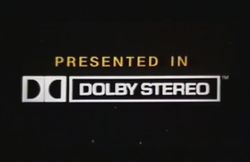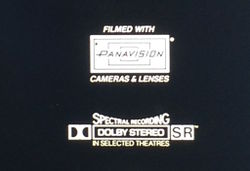Dolby A is a sound format that incorporates a Dolby A-Type noise reduction process. It is used in many aspects of analog recording but for the purposes of Sprocket School we will be talking exclusively about its use with 35mm stereo optical track prints and 35mm/70mm film prints with magnetic soundtracks. It is a 4 channel format- left, center, right and surround.
It was in use from approximately 1975 to 1986, when it was largely replaced by Dolby SR.
It is important for projectionists to be able to distinguish between Dolby A and Dolby SR because different circuitry within the sound processor is required to play them back correctly. If you playback Dolby A as SR or vice versa, it will not sound correct.
Via the [Dolby Stereo] Wikipedia page: "The optical soundtrack on a Dolby Stereo encoded 35 mm film carries not only left and right tracks for stereophonic sound, but also—through a matrix decoding system (Dolby Motion Picture matrix or Dolby MP[1]) similar to that developed for "quadraphonic" or "quad" sound in the 1970s—a third center channel, and a fourth surround channel for speakers on the sides and rear of the theater for ambient sound and special effects. This yielded a total of four sound channels, as in the 4-track magnetic system, in the track space formerly allocated for one mono optical channel. Dolby also incorporated its A-Type noise reduction into the Dolby Stereo system."
Dolby A vs. Dolby SR
Dolby A is difficult to distinguish from Dolby SR by sight. Here are some tips on telling them apart:
- Many studio films made between 1975 and 1985 will have Dolby A tracks.
- Some (but not all) films with Dolby A tracks will display the word "Dolby" - or "Dolby Stereo" rather than "Dolby SR" - with the Dolby logo in the end credits. But be careful, just because you see one of these in the credits of the film does not guarantee that it is A Type or SR. Some films were released as both mono and stereo prints, or a film may have been re-mastered and released as SR but was originally mono. Seeing the logo in the credits is just another clue to be used with alongside other sources of information.
- Some (but not all) films with Dolby A tracks will display the words "Stereo" on the edges of the film leader.
- A Dolby A track played in Dolby SR will usually sound harsh or blown out. A Dolby SR track played in Dolby A will sound acceptable, so if you really cannot figure it out Dolby A is the better choice.
-
Dolby Stereo logo.
-
Dolby Spectral Recording logo (SR)
External Links
- Wikipedia: [Dolby Stereo]
- Wikipedia: Dolby SR
- Wikipedia: [Dolby Pro Logic]

